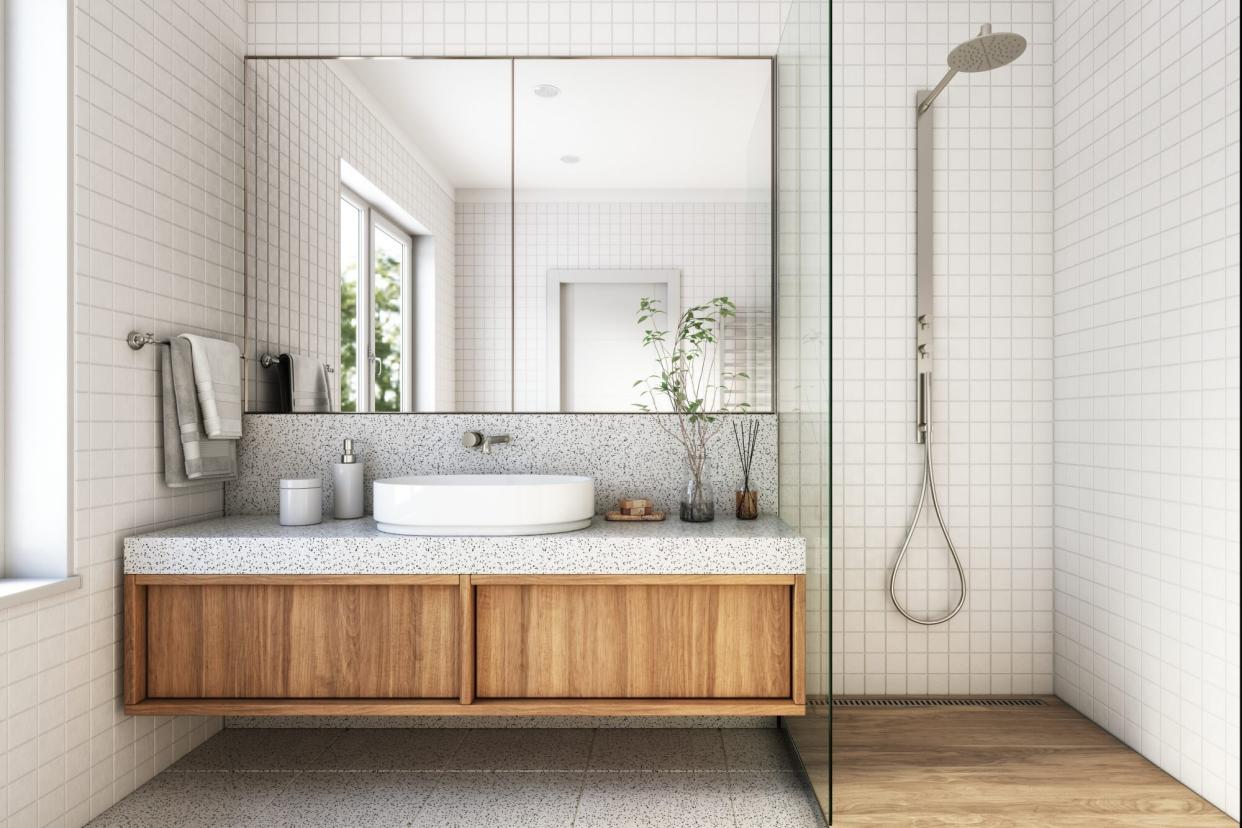Can You Paint Bathroom Tile? Here's Everything You Need to Know About Pulling Off This Low-Maintenance Renovation

GETTY IMAGES
TABLE OF CONTENTS
On This Page
Can You Paint Bathroom Tile?
Materials Needed
Preparation
Type of Paint
How to Paint
Painting Alternatives
Whether it lines the walls or is installed as flooring, many bathrooms typically feature some sort of tile. One of the biggest draws of the material is its durability—once it's in your home, it's there to stay and requires very little upkeep beyond routine cleaning. But when you want to remodel your bathroom, it can be difficult to work around tile's permanence.
One way people often opt to give their space a fresh look without tearing out the tile completely is by painting it. This might seem like a low maintenance way to revamp your restroom, but can painted tile withstand the humidity and high temperatures bathrooms often endure? It's possible, but you need to use the right technique and type of paint to successfully pull off this project.
Related: 13 Smart Ways to Upgrade Your Bathroom Without Renovating It
Can You Paint Bathroom Tile?
While you technically can paint bathroom tile, there are some instances in which you'd want to avoid this project all together. "We recommend painting over tile as a temporary solution, potentially in a lower traffic bathroom," says Gary McCoy, store manager at Lowe's. "Painting tile does not hold up in areas that get very humid or come in contact with water, so homeowners would especially want to avoid this project in areas like the shower."
Materials Needed
You'll need a few basic tools and materials to complete this project properly:
Trisodium phosphate
Tack cloth
Caulk
Putty knife
Waterproof spackle
120-grit sandpaper
Primer
Epoxy or two-process paint
Drop cloth
Paint tray
Paint roller
Paint brush
Polyurethane sealer
How to Prepare Bathroom Tile for Painting
Get your bathroom tile ready for this project by cleaning the surface, repairing any damage, and sanding down the area prior to applying primer or paint.
Clean the Tile
Start by giving the tile a thorough clean, which will help the paint better bind to the surface. "First, you'll need to clean the tile with a mixture of warm water and trisodium phosphate before rinsing with clean water and drying with a tack cloth," McCoy says.
Repair Damage
After cleaning, repair any chipped or broken tiles. Use caulk for small chips and a putty knife and waterproof spackle to fill in bigger cracks.
Sand the Tile
Sanding the tile will help minimize the chance that heat and humidity will break down the paint over time. "Sanding the desired tile area so that paint will properly adhere is critical," says McCoy. Use 120-grit sandpaper to remove the glaze on the tile, then rinse the area again and dry with a tack cloth.
Related: 6 Outdated Bathroom Trends Interior Designers Are Tired of Seeing
Type of Paint to Use When Covering Bathroom Tile
Using the correct type of paint is crucial when tackling this bathroom project. First things first: You must start with a primer as it will help the paint better bind to the tile. Following two layers of primer, apply either an epoxy or two-process paint. These are more durable and resistant to moisture and heat than other types of paint.
How to Paint Bathroom Tile
Now it's time for the fun part—painting! "The key to painting a tiled surface is to use thin coats and to allow plenty of drying time," says Annie Sloan, paint and color expert and creator of Chalk Paint Annie Sloan. "This gives each coat sufficient time to bond with the smooth surface of the tiles before it's disturbed by application of subsequent coats."
Apply two layers of primer, following the manufacturer's directions for drying times between each coat.
Once the primer is dry, add an epoxy or two-process paint to a paint tray.
Roll a light layer of paint onto the tile, using a paint brush to touch up where needed.
Apply up to three thin coats of your selected paint, allowing paint to dry between each layer.
Add a layer of polyurethane sealer to protect your surface.
Alternatives to Painting Bathroom Tile
If you only have one bathroom or all of your bathrooms are used frequently, you may want to avoid this project. Overtime, the paint can begin to chip away if it regularly endures high heat and humidity. Instead, try using peel-and-stick tiles for a fresh look. "Plus, if homeowners like to switch up their style often, peel-and-stick varieties are easily removable," says McCoy.

